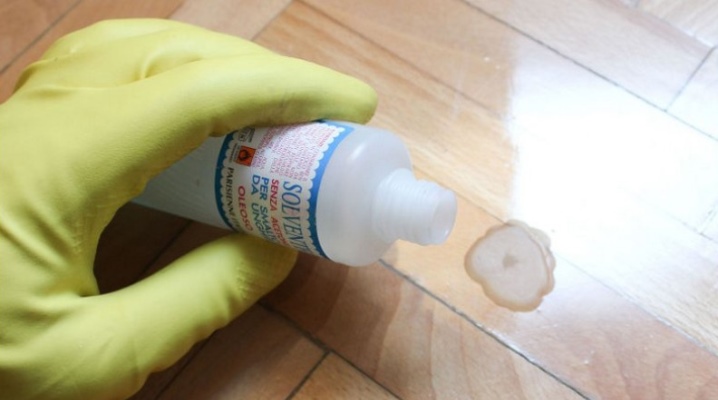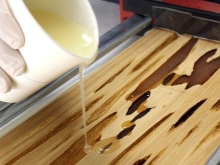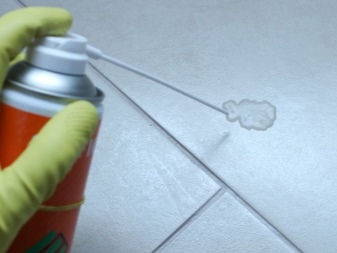How to wash epoxy resin?

Curing of any epoxy-based material is possible only after it reacts with the hardener, so it is much easier to process the stained area before its final polymerization. The chemical formula of epoxy resin has a complex structure, consisting of short polymer chains, which provides high strength to the composition. It is quite difficult to wash off such a hardened stain. In the article we will figure out how this can be done.



Mechanical cleaning methods
Removing epoxy stains at home can be done mechanically. Sometimes it is better than using chemical solvents. However, you absolutely cannot do without them.
How quickly the result comes depends on the size and age of the stain, as well as on the delicacy of the material on which it is applied.

Heat treatment
The area with the stain is treated with a jet of hot air from a building hair dryer. The process of removing cured epoxy is as follows:
- treat the stained area with acetone or any wash with dissolving properties;
- turn on the hairdryer, warm up the resin spot to a temperature exceeding 180-190 degrees (the limiting temperature of the heat resistance of the substance);
- as it heats up and liquefies, it is necessary to clean the influx;
- you can drop acetone into the center of the stain to clean more effectively;
- it is better to wipe off the resin with a sponge or soft cloth, but if necessary, a sharp knife can also be used;
- the remaining resin is reheated by repeating the process until the resin can be removed completely.
Usually it takes no more than 5 minutes to remove stains. If it is not possible to use a hair dryer, you can use a soldering iron. It heats the resin only through the paper layer.



Freezing
To remove an epoxy stain from a product, it does not need to be placed in the freezer chamber, especially since not in all cases there is such an opportunity. A special refrigerant must be purchased from the construction department.
But when working with him, you need to take care of safety: buy thick gloves, goggles, and a respirator. Working with refrigerant without them is hazardous to health.

How is the processing carried out:
- it is necessary to work only with open windows or with supply ventilation turned on;
- there should be no children, animals in the room;
- shake the can vigorously before using the product;
- spray refrigerant onto the hardened area with resin at a distance of 30 cm, while the bottle should be directed upwards;
- when the resin begins to crumble, it is important to immediately wipe off the epoxy, scrape off with a knife or spatula (you can try to break the stain with a hammer and use a vacuum cleaner to collect the crumbs).
If necessary, the refrigerant is sprayed onto the resin twice. Fragments of epoxy must be immediately thrown away, tightly packed in a plastic bag. This method is most suitable if the resin cannot be removed chemically, and thermal action is impossible due to the risk of surface destruction. Cut off the stain layer by layer to avoid accidental damage to the base.
If the scale of pollution is large, it will take more time and a lot of patience. The process is time consuming.


The use of chemicals
Although epoxy is considered a soluble material, not every solution can wash it off. Epoxy is characterized by high chemical resistance, therefore it is necessary to select a rather aggressive substance in order to dissolve it. Before purchasing the composition, you need to read on the label whether it is suitable for a particular situation. Many solvents can harm the skin, leave marks on stone surfaces, and burn through plastic. Special care will be needed when working with expensive furniture and textiles. After processing a fabric product by any of the methods, it is imperative to wash the thing in hot water with a powder familiar in composition.
To remove the stain without touching the base, you can try using enamel and varnish thinner or acetone. First, a couple of drops of the product are applied to the center of the epoxy bead, after which the reaction is evaluated. If the resin dissolves, then the cleaner can fix the problem. The areas of resin are wiped with such a means, while mechanically cleaning the surface.
Work is carried out exclusively in a respirator, with open doors and windows. It is advisable to clean in the open air as solvent vapors are highly toxic.

Do not pour a large amount of solvent on plastic and wood at one time - this will harm the material.
What else can you dilute the epoxy with after hardening? Epoxy can quickly dissolve methylene chloride, but it is such a caustic and toxic carcinogen that you should not resort to using it. Craftsmen at home are often used to clean up epoxy residues:
- nail polish remover;
- denatured alcohol solution;
- SP-6;
- DMF or DMSO.
There are more exotic ways to remove resin build-up after hardening. You can try to dissolve it with soda - Pepsi-Cola or Coca-Cola. A there are also tips on how to get rid of drips by using the pharmacy solution "Dimexide" in a ratio of 1: 3 with water. The location of the stain is moistened, and then they try to remove it.



A universal remover designed to remove old paint and varnish coatings can also help to cope with a caked stain. She also softens the hardened coating, followed by processing the resin on the surface with a construction trowel or knife. It is not easy to find a high-quality and effective wash now. It is intended for cleaning work surfaces, tools, but unsuitable as a solvent.
It is important to remember that sulfuric acid cannot be used to clean surfaces and soften epoxy.
In a chemical reaction with metals, this highly toxic oxidant burns through the wood. It poses a danger to human health. If it comes into contact with the skin, sulfuric acid leaves a chemical burn.


Precautionary measures
The use of chemicals and refrigerants to remove epoxy deposits requires the mandatory use of personal protective equipment: respirator masks, goggles and gloves. If the treatment involves spraying, a protective apron is required. The room where the work is carried out should be able to ventilate.
After the cleaning procedure, all protective items must be rinsed with running water and dried.


Useful Tips
It happens that during the cleaning process, a little epoxy glue gets on the skin (hands, other areas). This is mainly the case for those who neglect the recommendations for the use of protective gloves. If you do not react quickly, there is a high risk of getting a chemical burn or developing contact dermatitis. The following manipulations are required:
- immediately wash the site of contact with epoxy with soap;
- apply any disinfectant to this area;
- dry the treated area thoroughly with a soft cloth or paper towel.

Peel off your hands
It is allowed to use acetone to remove epoxy glue stains from hands, but this should not be done with sensitive skin. Acetone (nail polish remover) only treats the resin site, not the entire hand. Otherwise, cracks may appear on the surface of the skin. After cleaning with acetone, hands are washed using soap, any nourishing cream is applied to the skin.
If the contamination has already hardened, left unattended immediately, it must be impregnated with vegetable oil until it exfoliates thoroughly.

Wash off clothes
Eposidka is absorbed into the fabric instantly and hardens very quickly. Aggressive cleaning methods can damage the fibers and damage the item irreversibly. Small tar drips can be tried to clean up.
- Moisten the stain with 10% ammonia, ethyl alcohol. Wait a couple of minutes, then scrape off the resin with the corner of a spatula.
- Place the soiled thing in a tight bag and freeze for 2 hours. Then try to scrape off the epoxy from the fabric.
- Cover the tar spot with a clean sheet of paper, run a heated iron on top of it several times until the composition is completely melted. Then remove the resin with some suitable device.

Remove tar from tiles
Unsightly epoxy build-up is easy to remove when it comes to fresh stains. You will need a damp cloth and soapy water. Any method described above is suitable for dealing with hardened stains: heating, freezing, chemical solvents. The tile is resistant to almost any method of exposure. But you can remove the glue from the board only with a soldering iron. Other options will ruin the part with no chance of recovery.
Be extremely careful and careful when working with chemicals! Don't forget about safety measures!

For information on how to dissolve epoxy resin, see the next video.













The comment was sent successfully.